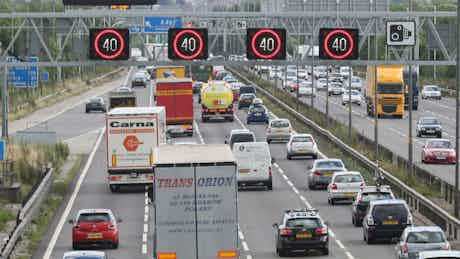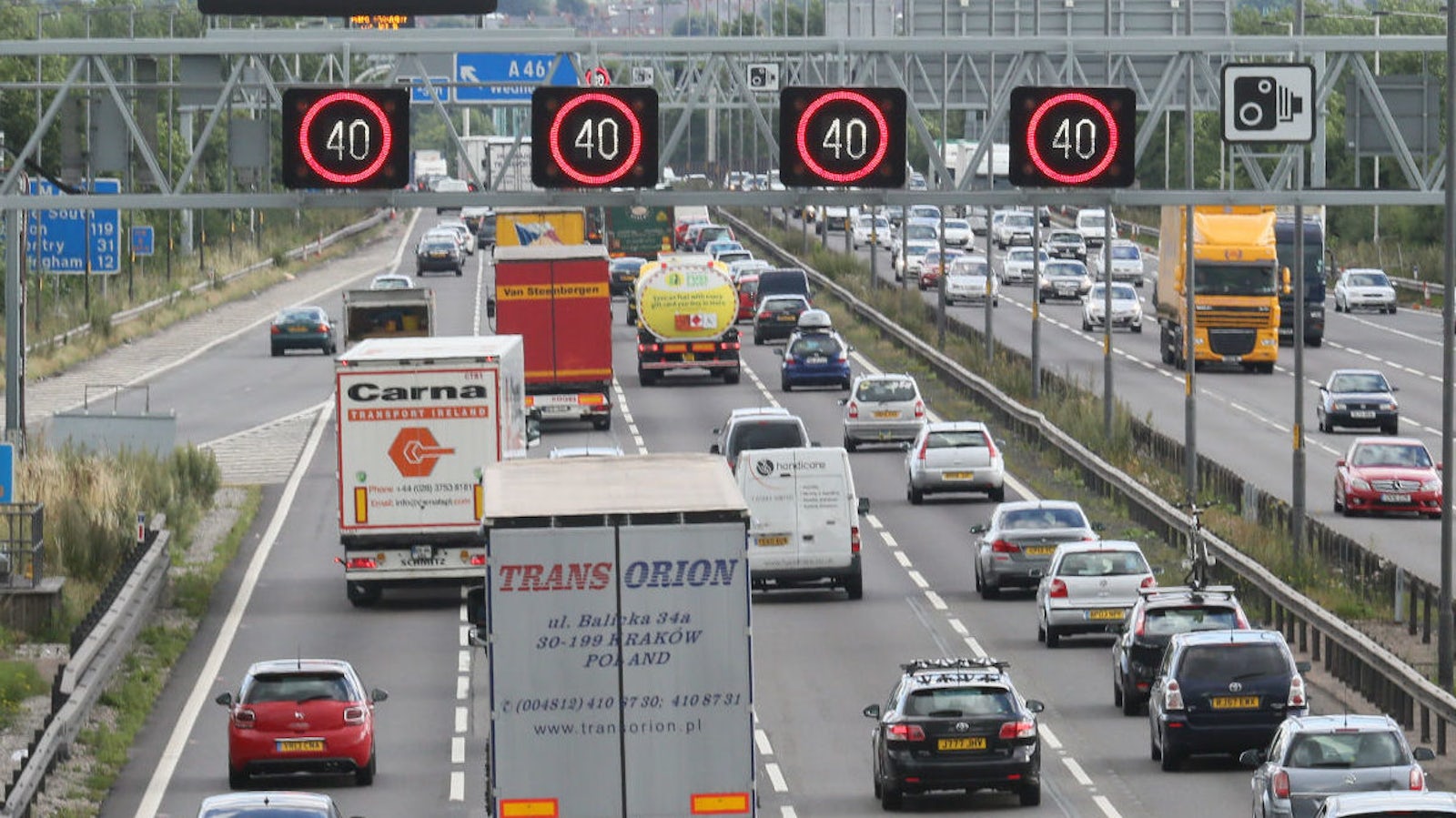Smart motorways – how safe are they, and why do they exist?
April 22, 2024 by John Rawlings

The introduction of so-called smart motorways in the UK has caused controversy and resulted in the government announcing the cancellation of plans to introduce any more. Why has this happened? Are they dangerous, and what are their pros and cons?
The UK’s first smart motorway appeared in 2006 as a solution to easing traffic congestion by using the hard shoulder as an extra carriageway.
Today, there are nearly 400 miles of smart motorways, but campaigners have raised serious concerns about their safety. The government has now announced it has scrapped all future plans to build more of them.
The likes of The AA and the BBC TV programme, Panorama, raised the profile of some serious safety risks associated with smart motorways. This follows severe and fatal accidents involving vehicles that have broken down on the inside lane of a smart motorway and were unable to reach the emergency refuge areas.
Smart motorways have radars and cameras to detect stranded vehicles on smart motorways, but a Freedom of Information request by BBC TV’s Panorama programme has revealed an alarming number of times when these were not working due to loss of power. Sometimes, these cameras and radars have not been working for up to 11 days at a time, putting vehicles and lives at risk.
In April 2023 the Department for Transport announced an extra £900 million had been earmarked for additional safety improvements. As part of these improvements, earlier this month it was announced that 52 extra emergency refuge areas are being installed on smart motorways in the south east, including the M25, M3, M4, M20 and M27. Lane closures will be in place during the roadworks, and are likely to cause traffic delays.
Nearly half (24) of these extra emergency refuge areas are on the M25, with 15 of them between J23 in Hertfordshire and J27 in Essex and and nine in Kent and Surrey between the M25/M26 intersection (J5) and the M25/M23 intersection (J7). Works start on Thursday 25 April, 2024 until late summer.
So what precisely are smart motorways, why do they exist, how do they differ from conventional motorways, and what should you do if you break down on one?
What is a smart motorway
Smart motorways feature a variety of technologies that aim to reduce congestion without the road having to be expanded or rebuilt at great expense. Smart motorways tend not to be complete lengths of individual motorways, but rather specific sections of existing road.
Not all smart motorways have the same set of systems, but the technologies featured include:
- Variable speed limits (present on all smart motorways)
- Sensors that measure traffic flow and can detect stopped vehicles
- Lanes that can be closed, indicated by red ‘X’ signs on overhead gantries
- Hard shoulders that can be turned into live lanes for traffic
- Emergency refuge laybys in place of hard shoulders

Types of smart motorway
There are three different types of smart motorway, and each works in a slightly different way.
All lane running motorway (ALR)

All lane running smart motorways do not have a hard shoulder, with the lane that was previously a hard shoulder permanently converted to a live lane for traffic. Emergency refuge laybys at regular intervals fulfil the role previously played by the hard shoulder. All lane running smart motorways are the most common type of smart motorway. An example of an all lane running motorway is the M3, between Junctions 2 and 4a.
Dynamic hard shoulder motorway
These types of smart motorway have a hard shoulder that can be turned into a live traffic lane by electronic road signs when traffic is heavy and more road capacity is needed. By default the hard shoulder is not a live lane, though, and it must only be driven on when signs indicate it should be. The M1 between Junctions 10 and 13 features a dynamic hard shoulder.
Controlled motorway
Controlled motorways have a permanent hard shoulder but feature variable speed limits, which are set depending on traffic conditions.

Although it wasn’t called such at the time, the first section of smart motorway technically appeared in 1996 between junctions 10 and 15 of the M25, when sensors in the road were introduced to measure traffic levels, and algorithms used this data to set variable speed limits enforced by speed cameras. This was an example of a controlled motorway back a quarter of a century ago and it remains one now, except it has now been extended to Junctions 10 to 16, while other sections of the M25 are also controlled motorways.
Why do smart motorways exist?
Motorways are the safest type of road in the UK. Government statistics show there were 49 accidents for every billion miles travelled on motorways in 2020, but 350 accidents – six times as many – per billion miles driven on A roads.
The inherent safety of motorways means road bosses want people to use them, but motorway congestion can see drivers divert onto other, more dangerous types of road such as dual carriageways and B roads.

Building new motorways or widening existing ones to take more traffic is extremely expensive, and is often not practicable due to the roads running past cities and geographical features such as hills and rivers. Utilising the hard shoulder – either permanently, or temporarily when traffic volumes are high – creates extra capacity while costing roughly 60% less than motorway widening.
Smart motorway safety
Motorway drivers have become used to having hard shoulders over the years, and there can be a significant impact to their removal in terms of drivers’ perceptions of risk.
Smart motorways are, according to their critics, more dangerous than conventional ones, while a number of high-profile collisions on smart motorways have made headline news.
The roads have also received improvements – although some have argued these should have been in place as soon as smart motorways were first introduced.
Improvements include:
- More emergency refuge areas, shortening the distance between each layby
- More signs, advising drivers how far they have to go before they get to the next place they can safety stop
- Emergency refuge areas have been painted orange to make them more visible
- The rollout of systems that automatically detect vehicles that have stopped in live lanes has been increased. This technology is due to be standard across all lane running smart motorways by September 2022.
- 96% of smart motorway speed cameras have been upgraded, allowing them to detect people driving in closed red X lanes

Accident data for smart motorways is mixed. Department for Transport (DfT) statistics show conventional motorways actually have a higher rate of fatalities than all types of smart motorway, for example. On the other hand, the proportion of what are termed ‘slight’ casualties is higher on smart motorways than conventional ones.
The DfT’s stocktake on smart motorways concludes: “Overall, the evidence shows that in most ways, smart motorways are as safe as, or safer than, conventional motorways, but not in every way.”
How to drive on a smart motorway
The main principles for driving on a smart motorway are the same as for driving on a conventional motorway:
- Use the left-hand lane unless you are overtaking or need to let traffic join the road
- Indicate to let other drivers know you are changing lanes
- Be aware of traffic around you at all times, and especially when changing lanes
- Do not drive based just on what the car in front is doing: look further ahead down the road
- Drive within the speed limit, reducing your speed if traffic or weather requires
- Leave plenty of space between your car and the vehicle in front
- Take a break from driving every two hours.
Smart motorways do bring some additional rules, though:
- Do not drive in a lane with a red X above it. This sign means the lane in question is closed, possibly due to a collision or broken-down vehicle. Driving in a red X lane is illegal, and cameras enforce the law, with drivers who disobey these signs face three penalty points and a £100 fine.
- Stick to variable speed limits, which will be shown on overhead gantries and/or signs by the side of the road
- Do not cross the solid white line and drive on the hard shoulder unless signs tell you to do so
What to do if you break down on a smart motorway
The prospect of breaking down on a motorway without a hard shoulder is frightening, but there are a number of things to bear in mind about this scenario.
The first is that cars tend not to spontaneously fail, often giving warning signs (such as a flashing engine management light, or a loss of power) before they stop working. A car travelling at 70mph can also often cruise for a significant distance should the engine fail, potentially allowing you to get to a refuge area if there is no hard shoulder.
National Highways, the organisation that runs the UK’s motorway network, advises drivers to do the following in an emergency:
Go left, coming off at the next junction if possible, or moving across the motorway to the hard shoulder or nearest refuge area. Once there, occupants should leave the car from the passenger side and get themselves behind the crash barrier and on to the verge, standing behind the car rather than ahead of it.
Drivers who break down in a live lane should stay in the car with their hazard lights and seatbelts on and dial 999.
Which motorways are smart motorways?
The following list was drawn from a map published by National Highways in 2021. Sections marked * were under construction at time of publication.
All lane running motorway
M1 Junction 13 – 16*
M1 Junction 16 – 19
M1 Junction 24 – 25
M1 Junction 28 – 31
M1 Junction 32 – 35a
M1 Junction 39 – 42
M3 Junction 2 – 4a
M3 Junction 9 – 14*
M4 Junction 3 – 12*
M5 Junction 4a – 6
M6 Junction 2 – 4
M6 Junction 11a – 13
M6 Junction 13 – 15*
M6 Junction 16 – 19

M20 Junction 3 – 5
M23 Junction 8 – 10
M25 Junction 5 – 7 (ALR westbound, controlled J6-J7 eastbound)
M25 Junction 23 – 27
M27 Junction 4 – 11*
M40 – M42 interchange*
M56 Junction 6 – 8*
M62 Junction 10 – 12
M62 Junction 18 – 20
Dynamic hard shoulder motorways
M1 Junction 10 – 13
M4 – M5 interchange (M4 Junction 19 – 20 M5 Junction 16 – 17)
M6 Junction 4 – 5
M6 Junction 8 – 10a
M42 Junction 3a – 7
M6 Junction 5 – 8
M62 Junction 25 – 30 feature a mix of smart motorway types: Junction 25 to 26 and Junction 29 to 30 westbound are all lane running; Junction 26 to 28 and Junction 29 to 30 eastbound are dynamic hard shoulder; and Junction 28 to 29 are controlled motorways
Controlled motorways
M1 Junction 6a – 10
M1 Junction 23a – 24
M1 Junction 25 – 28
M1 Junction 31 – 32
M6 Junction 10a – 11a
M20 Junction 5 – 7
M25 Junction 2 – 3
M25 Junction 7 – 10
M25 Junction 10 – 16
M25 Junction 16 – 23
M25 Junction 27 – 30
M42 Junction 7 – 9
M60 Junction 8 – 18
Looking for an easy way to change your car? Then Carwow is the place to go. You can sell your car online for a great price, and get the best deals on a new one. All through our network of trusted dealers and all from the comfort of your home. Tap the button below to get started today.















